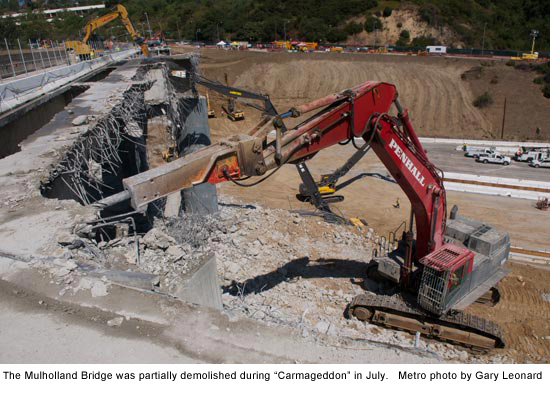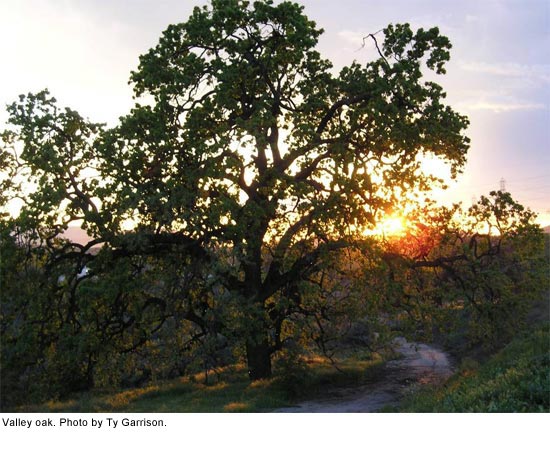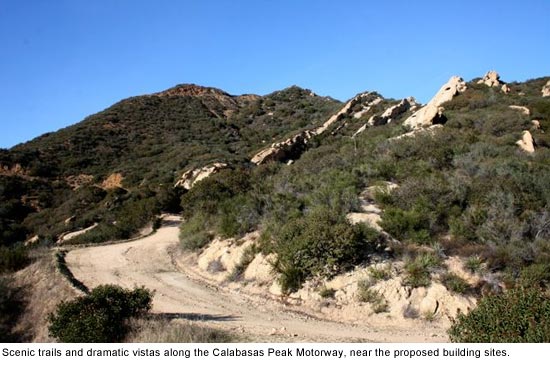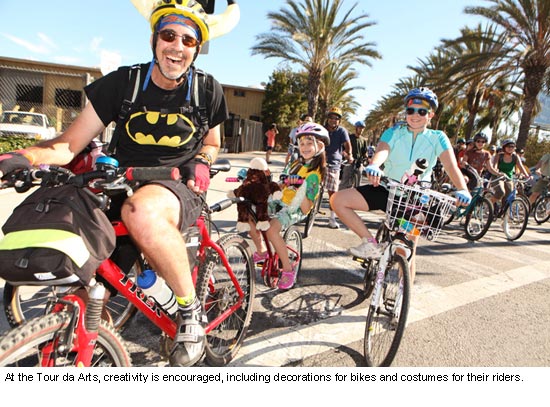Steering clear of Mulholland Bridge
August 25, 2011
They were looking for a sign—and they’re getting one.
Five signs, to be exact: moveable electronic message boards that will warn of congestion ahead on the Mulholland Bridge.
As classes get underway next week at schools along the Mulholland corridor, residents and parents alike are bracing for some of the worst morning rush hour traffic in memory. Last year, eastbound traffic had a dedicated right turn lane on the bridge. This year it’s gone, and traffic has been reduced to a single lane in each direction.
That’s because even though Carmageddon has come and gone (at least the first part), the 405 Project is entering a busy new phase with construction on multiple fronts. The Mulholland Bridge—gateway to numerous schools, serving some 2,700 students in all—promises to be one of the more challenging locations as workers prepare to rebuild the south side of the bridge that was torn down in July.
To help deal with the anticipated tie-ups, schools in the area have added extra buses and are heavily promoting carpooling. And everybody involved is trying to relay this message to motorists: stay away unless you absolutely have to be in the area.
“Kind of like Carmageddon, we really need to get the word out prior to the event, rather than during the hysteria of being in it,” said Laurie Kelson, who represents the Encino Neighborhood Council on the project’s community advisory council.
“It is going to hit us very hard. We’ve been working for Metro for the past 18 months,” added Robert Woolley, who represents the Mulholland Educational Corridor Association on the 405 Project’s community advisory council. He said that schools in the area have long staggered their start and dismissal times, and are increasing the number of bus routes this year from 9 to 13. Some larger buses also are being used.
At Woolley’s institution, the Mirman School, a quarter of the students will be coming by bus this year—up from 10%-15% last year. Other schools in the corridor include Berkeley Hall, Curtis, Westland and the Stephen S. Wise Temple and Schools, along with the Bel Air Presbyterian Church preschool. American Jewish University also is located nearby.
Ron Macias, a Metro community relations officer, said the message signs have been placed at key intersections in Encino, Encino Hills and Sherman Oaks. The goal is to warn unsuspecting motorists well before they head into the construction zone—and to let longtime commuters know that their alternate routes through the area will likely be more headache than they’re worth.
Macias said traffic officers also will be on hand next week to keep traffic moving in the area. He said a proposal to create a shuttle for students coming from Encino is under consideration.
Next week also brings a nighttime closure of the southbound 405 and the Sunset Bridge as contractors pour new decking on that structure on Monday, August 29. Sepulveda Boulevard will be closed from Montana Avenue to Church Lane from 10 p.m. on Wednesday, August 31, until 6 a.m. the next day. Details are here.
More disruption can be expected in November, when long-running ramp closures go into effect so work can begin on flyover ramps at the intersection of Wilshire and the 405.
The 405 Project, which will add a 10-mile northbound carpool lane to the freeway along with other improvements, is set to wrap up in 2013.
“It’s just going to affect a lot of people’s lives for a long time,” Kelson said.
Posted 8/25/11
Seeing the forest and the trees
August 25, 2011
Few living things are as integral to Los Angeles as its mighty oak woodlands. They fed wooly mammoths and sheltered Native American tribes.
They’ve supported thousands of species of birds, mammals, reptiles and insects. They were remarked upon in the 1769 diaries of the awestruck Franciscan missionary, Father Juan Crespi. Even now, scattered though they may seem, they inspire reverence, rising from the chaparral like ghosts of another California. Unfortunately, as much as 80% of Los Angeles County’s original oak woodlands have been destroyed.
For the last several decades, environmentalists have waged an uphill battle to preserve the county’s 145,000 remaining acres of oak woodlands. Their successes have included a 1982 county ordinance that has made it difficult to cut down mature oak trees.
Still, the existing law is oriented toward regulating the removal of individual oak trees rather than preserving an entire ecosystem. As a result, while single trees enjoy some protection, the woodlands themselves—which filter pollution, absorb carbon dioxide, anchor stream banks and hillsides and slow floodwaters—remain vulnerable to everything from development to falling water tables. So on Tuesday, the Board of Supervisors took a step toward not only conserving L.A.’s beloved native species, but also toward making it easier for individual property owners to voluntarily do the right thing.
“The purpose of this is partly to raise the profile of this important ecosystem,” says Rosi Dagit, a senior conservation biologist at the Santa Monica Mountains Resource Conservation District who for the past three years has coordinated a strategic alliance of environmentalists, foresters, arborists, building industry representatives, fire officials and other interested parties in developing an oak woodlands management plan.
The group’s report offers two sets of recommendations. The first set, adopted by the Board on Tuesday, includes maps and a conservation strategy that make the county eligible for state woodlands conservation money that, in turn, will help buy land for public trusts and conservation easements.
The report also suggests ways that private property owners—who still control a quarter of the county’s woodlands in large tracts such as Newhall Ranchand small communities such as Topanga Canyon and Monte Nido—can voluntarily help preserve them by, for instance, donating land and easements themselves, thus reaping income, property and estate tax breaks.
The second set of recommendations, which was sent to staff for a report in six months on its potential for implementation, includes ways to incorporate oak woodland conservation into the general plan and important guidelines for such things as assigning a dollar value to a tree’s importance in mitigating global warming or as a source of flood control. It also includes a number of revisions to the existing oak tree ordinance.
For instance, Dagit says, under existing rules, property owners dread oak trees almost as much as they love them because they are required to pay for a pricey permit to cut one down after it reaches more than 8 inches in diameter.
“It’s several hundred dollars just for the permit,” she says, “and then you have to pay an arborist to do an oak tree report, which is several hundred more, and then if it’s more than one tree, you have to pay for a hearing, which can cost thousands of dollars. So typically, if a little oak tree volunteers in their yard, a lot of people don’t want the hassle—before it can reach 8 inches, they take it out.”
This is problematic, she says, because oak trees bind Los Angeles in more ways than Angelenos realize, from securing the soil and creating drainage to mitigating the city’s carbon footprint. “Each mature oak tree takes out nine tons of carbon a year,” says Dagit, “so we want to plant them, even if they’re only going to be around for 10 or 15 years.”
Under the proposed recommendations, property owners who might love to have a stand of oak trees but fear the potential for bureaucratic problems can head off future costs by planting trees themselves and providing a map (even a hand-drawn one) to the county.
“Then, ten years later, if you wanted to take out one of those oaks to put in a tennis court or whatever, you could do what you needed to do without a penalty,” says Dagit. “And meanwhile, the public will have reaped the benefit.”
This, she says, would be especially helpful in places like landfills, where oaks would be the perfect ground cover were it not for the owners’ fear of future impediments should a need to, say, get to some piping, require them to tear out a tree.
Dagit stresses that the current report is intended to make conservation easier, not harder: “We want to provide incentives for people so oaks won’t be considered a liability.”
But, she says, the woodlands continue to dwindle, and so far, not one section of oak woodland has been fully restored or recovered. “Trees are the background assumption of our life,” she says.
“People look out the window and think that the trees will always be there. But will they be?”
Posted 8/25/11
Homing in on Topanga development
August 25, 2011
The public is being invited to weigh in on what should be included in an environmental review of plans to build four homes on a Santa Monica Mountains ridgeline above Topanga Canyon.
The residences would be built on previously undeveloped land along the Calabasas Peak Motorway—a 40-plus acre expanse bordered by open space and trails on the west and south, and “low density” residential on the north and east.
The scenic ridgeline has long been a visual boundary marker between Calabasas and Topanga Canyon, and overlooks both areas.
Each of the proposed homes would be located on a 10-acre site on the property, which has been designated a “significant ridgeline,” meaning that any development within 50 feet would require a variance to the county’s ridgeline ordinance. In preparation, the county is preparing a single environmental impact report for all four homes—and now is seeking public input to determine all the issues that the EIR should explore.
The scope of work proposed for the four homes “will create potentially significant impacts to the significant ridgelines, native flora and fauna, and raises issues of concern for safety which will be resolved under one Environmental Impact Report (EIR) for the project area,” according to a notice of preparation by the county’s Department of Regional Planning.
The notice says that the project would require installation of a 277,000-gallon water tank at the ridgeline’s highest peak, as well as four septic systems. There are coast live oaks throughout the property; the report said a permit would be needed to “encroach upon the protected zone for three oak trees to widen the existing Calabasas Peak Motorway to Fire Department standards.”
An overview of what’s being proposed will be presented at a public meeting on Wednesday, Aug. 31, at the Topanga Community House, 1440 N. Topanga Canyon Boulevard, from 7 p.m. to 9 p.m. Regional planning officials are asking for suggestions and comments from the public at the meeting, or in writing by Sept. 15.
Learn more about the project here, or at the Calabasas or Agoura libraries.
Posted 8/24/11
Buggy nights in Malibu
August 24, 2011
Instead of cursing the ants in the pantry, show bugs you know where they live. Take the whole family to “Buggy Nights,” a twilight nature expedition Saturday in Malibu’s Charmlee Wilderness Park.
Hikers bring their own flashlights to search for insects, spiders, and other arthropods, setting out from the nature center to explore the trails. UV lights are placed back at the nature center to attract more critters to examine when the group returns.
Charmlee Wilderness Park has eight miles of trails over 532 acres of coastal slope in the Santa Monica Mountains. Buggy Nights is just one of the park’s public, school and group nature programs. Get information about others from City of Malibu’s Recreation Guide and Quarterly Newsletter.
Reservations are required for the hike–call (310) 317-1364 to save a spot. Dress appropriately and bring $4 for parking. The bug hunt heads out at 7 p.m. this Saturday, August 27, at 2577 Encinal Canyon Road.
Posted 8/24/11
Making sure bikes count in Los Angeles
August 24, 2011
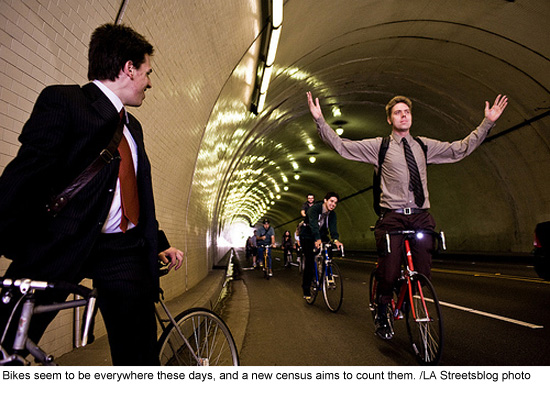
Bicycling is big in Los Angeles these days, but how many folks are actually out there using pedal power to get around? Have their ranks increased in the past two years? The Los Angeles County Bicycle Coalition hopes to learn the answers to these questions, and others, from the 2nd City of L.A. Bike Count.
The bike advocacy group is recruiting counters for 50 locations in downtown L.A., the Westside, and the San Fernando Valley. The cycle census takes place during rush hours on Tuesday, September 13 and around noon on Saturday, September 17. To volunteer, sign up online or email Martin Lopez-Iu at [email protected].
Volunteers will count bikes and record details about the riders, including gender, whether a helmet is used, if they are on the sidewalk or road and if they are observing traffic laws.
The numbers will be compared to data collected in 2009, when Los Angeles’ first bike count in twenty years recorded more than 14,000 cyclists. Survey results will be used to help city and county governments plan and develop infrastructure to make local streets more bike-friendly.
Posted 8/24/11
Happy 100th to San Fernando, Van Nuys
August 23, 2011
Van Nuys and the City of San Fernando celebrate their centennials this weekend, and officials are throwing free outdoor parties to mark the occasion.
Van Nuys’ 100th happened back in February, but there’s a celebration this Saturday, August 27, with a street fair that features “A Taste of Van Nuys” from local restaurants, a car show from the Wild Bunch, a 1950s dance party and vendor booths and games. The party lasts from 4 p.m. to 8 p.m. at the Van Nuys Civic Center, 6200 Van Nuys Boulevard.
San Fernando’s birthday celebration features danceable rhythms from the Cuban-styled salsa group Orquesta Charangoa. Their performance, sponsored by the Los Angeles County Arts Commission with funding provided by Supervisor Zev Yaroslavsky, is part of the city’s Summer Concerts series. To accompany the music, several of L.A.’s gourmet food trucks will be on hand. And, of course, no birthday party would be complete without a cake. If you want to join in the fun, head to Recreation Park, 208 Park Avenue, this Sunday, August 28, at 6:30 p.m.
Posted 8/23/11
Seriously crossing the line
August 19, 2011
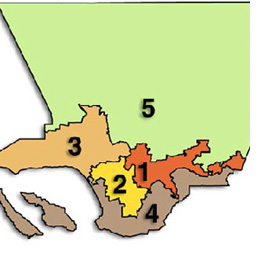 As a member of the Board of Supervisors since 1994, I’ve had the privilege and responsibility of representing nearly 2 million people woven together in a district that encompasses the Westside, the San Fernando Valley and the Las Virgenes region—all in the virtual shadow of the Santa Monica Mountains.
As a member of the Board of Supervisors since 1994, I’ve had the privilege and responsibility of representing nearly 2 million people woven together in a district that encompasses the Westside, the San Fernando Valley and the Las Virgenes region—all in the virtual shadow of the Santa Monica Mountains.
The residents of the Third District share more than a cohesive geography. Although ethnically diverse, they share common government services, transportation, environmental interests and much more.
Now, all this is being placed in serious jeopardy by a bald-faced gerrymander that is completely unnecessary. Proponents claim it’s needed to comply with the law, but that just isn’t so.
Like the state and federal governments, counties must redraw their district boundaries every ten years to conform to the results of the U.S. Census. But unlike the recently completed state and federal efforts, which were performed by citizens’ panels, the county’s redistricting must be decided by the Board of Supervisors.
As part of this process, two proposed maps (denoted as T1 and S2) were submitted this week that would radically redraw the Board of Supervisors’ district boundaries, leaving communities fragmented and an estimated 3.5 million people suddenly represented by a supervisor for whom they never cast a vote. Worse, some of these same people would be denied the right to vote for a supervisor for as long as six years because of the timing of elections.
The scope of the fallout would be vast and swift, potentially undermining the ability of communities to speak with one voice as advocates for their common interests. For example, the San Fernando Valley, which has fought hard to maintain its own identity, would be carved into three different districts. Hollywood and mid-Wilshire, meanwhile, could be included in a district with such distant cities as Lomita and Cerritos.
(Here are the current district boundaries. Click here for the T1 plan and here for the S2 plan.)
As you know, I’m currently in my final term as a supervisor so I have no personal interest in the electoral composition of the districts—even if it means that, for my term’s duration, I would no longer represent communities I’ve been honored to serve for nearly two decades. However, I’m utterly convinced that these redistricting schemes would significantly injure our ability to fight together to improve transportation in our communities, keep a close watch on development issues, extend health care to our underserved population and protect the environment of the Santa Monica Mountains and the north Santa Monica Bay.
The county’s redistricting plan must adhere to the Federal Voting Rights Act, a bulwark of the civil rights movement in our country and a guarantor of democracy for all Americans. The Voting Rights Act protects the rights of designated minorities to an equal opportunity to elect candidates of their choosing. Both of the proposed maps create two districts in which Latinos would comprise more than half the voting-age citizens, instead of one such district now.
But contrary to the arguments put forward by supporters of the proposed maps, their adoption is not required by this law. The Voting Rights Act requires an equal opportunity for minority groups; it does not require the creation of districts in which a single minority group comprises more than 50% of the voting age citizenry. The Federal courts have ruled that “fifty percent” districts are only required when voting is so racially polarized that non-minorities consistently vote against minority-preferred candidates to such an extent that those candidates are denied an equal opportunity to win.
Frankly, the notion that non-minorities won’t vote for a minority candidate in L.A. County is antiquated. Los Angeles in 2011 is not the same as the Los Angeles of forty, thirty or even twenty years ago. Our county is politically and socially far more mature and broad-minded.
In the last decade, many elections have been won by Latino candidates even where Latinos did not represent a majority of the voters. These candidates include Mayor Antonio Villaraigosa, Sheriff Lee Baca and County Assessor John Noguez.
I strongly believe that it is possible to redistrict this county in a manner that protects the voting rights of minorities without dismembering established communities of interest, without shifting nearly 40% of our population from one district to another, and without relying on antiquated assumptions about the voting behavior of different segments of the electorate. The federal courts have given us the roadmap to get this done, and have consistently rejected efforts to use the Voting Rights Act in the way the backers of these new plans propose.
The Board of Supervisors will hold a hearing on the proposed redistricting plans on Tuesday, September 27, at 9:30 a.m., in Room 381 of the downtown Kenneth Hahn Hall of Administration, 500 W. Temple St. I urge you to attend and make your voice heard on this crucial issue for our community. If you’re unable to attend, I ask that you communicate your concerns to the board members by writing or e-mailing
[email protected].
Posted 8/19/11
A giant swim with a giant heart
August 18, 2011
When hundreds of swimmers take to the waves of Santa Monica Bay this Sunday morning for the OptimisSport Distance Swim Challenge, they’ll join a cause that began as the personal challenge of one man, but became a rallying point to protect and improve the lives of millions of young people.
The event, now in its second year, was conceived, literally by accident, by Alan Morelli, CEO of OptimisSport.
Morelli said a motorcycle spill 2½ years ago broke 17 of his bones, mangled his foot and severely injured his spine, leaving him unable to move his lower extremities.
At first unable to make it across the pool during rehabilitation, he nevertheless told friends that he would eventually swim across Santa Monica Bay. Incredulous, several replied that if he could do it, they would make the swim, too.
By 2010, that idea had coalesced into the inaugural Distance Swim Challenge to be held that October. Morelli was describing the event to a group of friends near his home in Pacific Palisades, when one of them, former NFL star Marcellus Wiley, became interested. Just one problem: Wiley had to learn to swim first.
They had just 11 weeks to prepare him to handle 1.2 miles of open water.
Then, the day of Wiley’s first swim lesson, tragedy struck across the country in Shreveport, Louisiana, where six African American teenagers drowned in the Red River during a family get-together.
The catastrophe drew new attention to the need to teach swimming to black children; studies have found that nearly 70% of African American young people have not been taught how to swim.
The news turned Wiley, a 6’4” former defensive lineman, into an (even more) unstoppable force. After intense training sessions, he able to complete the 1.2-mile swim, which he said was “like playing an entire NFL season in one day.” The effort drew national news coverage from ESPN, CNN and Oprah Radio.
Wiley will be watching from the sidelines this year because of a torn Achilles tendon. Also attending, according to Morelli, will be NFL Hall of Famer Jerry Rice, USA soccer gold medalist Julie Foudy and Ous Melloulli, who won the gold in Beijing for the 1500 meter freestyle.
Morelli, on the other hand, will attempt to swim 12.6 miles–from Manhattan Beach to Venice, a distance he calls “insane.”
The swim takes place on Sunday, August 21. Register online by August 19 to participate in individual or team swims of 1.2, 2.4, 4.8, and 12.6 miles. The cost ranges from $55 to $440 depending on distance and the number of people in your group. Prior experience is a prerequisite for the longer swims. See the website for qualifying requirements, frequently asked questions and an athlete guide (PDF).
For people who aren’t ready for such grueling distances, the “Fun Swim” offers a leisurely way to get wet. A 500 meter swim will be held for ages 12 and up, and there is a “fun splash” for kids under 12. Registration is $10 for adults and $5 for kids under 18.
All events will be monitored by lifeguards, and all proceeds go to the charities Exceeding Expectations, Splashball and Save the Team. Registration starts at 6 a.m., and the swims last until the final stragglers are called ashore at 5 p.m. See the full schedule for specific race times and starting locations.
Those who prefer to stay dry can still check out the swim free of cost at Venice Beach near Navy Street, where all the swims finish.
Posted 8/18/11
Pedaling art in Santa Monica
August 18, 2011
There’s art, there’s entertainment, there’s exercise, there’s environmentalism. And sometimes they all come together in one magical day that just happens to involve bicycle bells, flamenco dancing and, yes, food trucks.
That day is Sunday. The place is Santa Monica. And the ride of choice is (you guessed it) the bicycle.
The Santa Monica Museum of Art rolls out “Cause for Creativity: Tour da Arts, Vol. 3,” uniting cycling and art communities for an afternoon of fun that won’t leave a big carbon footprint. Visual art, spoken word, live music and dance are all in the offing during a scenic bicycle tour of the city.
Bikers will meet at the museum at high noon for check-in and a Cycling Mini-fest, where event partners will provide services, education and entertainment. Attendees can tune up their bikes with Bikerowave, get current on bike advocacy with groups like the Los Angeles County Bicycle Coalition and check out the hottest in bike riding fashion (it’s not all spandex). It’s also a good time to check out the Museum’s exhibitions, or add a little “bling” to your bike at the Spoke Card Art Workshop ($5 for nonmembers.)
Every cyclist will be given a free bicycle bell for the ride, and free bike bags will be handed out to the first 150 people who show up.
The tour itself embarks at 2:30 p.m., and heads to The Broad Stage for music and a world dance performance from Global Motion and Synapse Contemporary Dance Ensemble of Santa Monica College. The ensemble is an all-student dance group, choreographed by faculty, which has performed in venues across the city, country and world. It will present five contemporary global dance works, including flamenco dancing and a Polynesian dance to the world music hit “Tutuki.”
Next stop is Santa Monica City Hall, where cyclists join a free public performance of “Jazz on the Lawn” with the Electones, sponsored by L.A. County Supervisor Zev Yaroslavsky as part of the county Arts Commission’s free concert series. And since riders are already there on pollution-free pedal power, they can show their depth of commitment to the environment by grabbing a free reusable shopping bag, courtesy of the Santa Monica Office of Sustainability and the Environment’s “Bring Your Bag” initiative.
At 6 p.m. the caravan returns to the museum for a sonorous and collaborative finale with the “Bicycle Bell Ensemble.” Riders join professional musicians, chiming in time to create a bike bell orchestra (practice sessions are earlier at the Mini-fest).
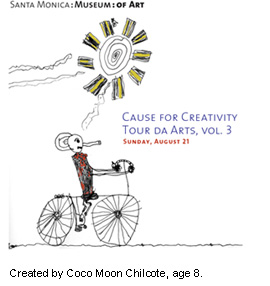 The total distance of the ride is about 7 miles. Healthy snacks and drinks donated by a variety of vendors will be provided at each stop. For something more substantial, mobile food vendors Mandolin Grille, L.A. Snowie, and Dosa Truck will be stationed at the museum to sell their gourmet concoctions.
The total distance of the ride is about 7 miles. Healthy snacks and drinks donated by a variety of vendors will be provided at each stop. For something more substantial, mobile food vendors Mandolin Grille, L.A. Snowie, and Dosa Truck will be stationed at the museum to sell their gourmet concoctions.
The event, the third of its kind, is the latest collaboration between Santa Monica Museum of Art and Cyclists Inciting Change thru Live Exchange (CICLE), which manages ride logistics to ensure the safety of the group. Last year’s “Tour da Arts” attracted about 400 riders. Elizabeth Pezza, the museum’s assistant director of communications, says that she expects even more this time around.
“It’s one of the largest organized rides on the Westside, and it’s the only one I know of that has organized events at each stop,” Pezza said.
Asuka Hisa, the event organizer and the museum’s director of education, first conceived of bringing people together in this way four years ago, when she was “feeling the cycling vibe in the city of L.A.” The event became part of the museum’s “Cause for Creativity” program, which aims to raise social awareness through engagement with the arts. Hisa relied on previous work experience in planning the event.
“I drew on my experience being an arts commissioner with the City of Santa Monica,” she said. “This was a great way to broaden the audience and engage the residents in the rich cultural resources of the city. It’s been so beneficial for everybody.”
The museum also got the public involved in creating signature graphics for the event, requesting submissions from kids for a “Bike Critter Art Contest” in July. Word of the contest spread quickly on Facebook and Twitter, and hundreds of submissions came from as far away as China and South America. A jury of artists made the final call, choosing a mouse-like creature by 8-year-old Coco Moon Chilcote of Philo, CA.
And the creativity isn’t limited to the artists. Some of the participating cyclists are expected to arrive in costume atop wacky custom rides.
The tour takes place this Sunday, August 21. Online registration is highly recommended if you want to join in. Directions to the museum and further details about the event (there are some basic safety requirements) can be found on its website. And if you want to see what last year’s ride was like, check out this video.
Posted 8/18/11




